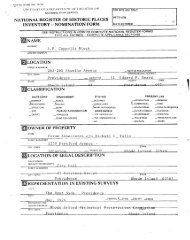1 Dr. Jonathan Prude, Emory University “The Great Transformation ...
1 Dr. Jonathan Prude, Emory University “The Great Transformation ...
1 Dr. Jonathan Prude, Emory University “The Great Transformation ...
You also want an ePaper? Increase the reach of your titles
YUMPU automatically turns print PDFs into web optimized ePapers that Google loves.
7within reach of at least middling sorts. But hardly less important was that the spread of ruralindustrial manufacturing itself into the countryside provided new employment opportunities andso new reasons for people to enter or stay within rural townships. The employment might beinside manufactories. But it might also involve participation in the outwork networks industrialproduction often fostered. It might, that is, involve participating in systems by which parts ofshoe or palm-leaf hat fabrication, for example, were given out to members of farminghouseholds--usually wives and daughters--to be worked up and then returned to central locations.Nor was it difficult to view textile mills in this light. For if they obviously helped diffusemanufactured textile goods across the countryside, they also provided employment. And againtheir employment ranged from workers inside the manufactories to others--with these others inthis case including local artisans serving the mills’ technologies and construction needs and, atleast at first, impressive flocks of outworkers. Rhode Island-style factories often started out usingoutworkers (once more mainly females) to prepare wool and cotton for their machines by“picking” it clean. And since many of these factories, even early on when they limitedthemselves to spinning operations, aimed to market cloth as their end product, they commonlycombined their water-powered spinning of yarn with networks of outworking handloom weavers(again mainly women) laboring in their homes. In their first few years of existence, the southernMassachusetts mills I studied employed some 150 pickers and more than 700 handloom weavers,with the latter contingent spilling into 29 townships in three states and covering some 800 squaremiles. (Figure #2) And then, as a vital added bonus, the workers inside mill buildings comprisedready consumers for the foodstuffs produced by nearby husbandmen.In these ways, for these reasons, the presence of industrial enterprises in rural townshipslike those of southern New England might well have seemed a solution to vexing problems. Forworking inside these enterprises might well have appeared to offer employment capable ofoffsetting eroding husbandry, while the outwork wages and foodstuff-customers these sameenterprises provided to farming families might well have seemed to offer ways for suchhousehold both to continue farming and pay their mounting bills.















